Are you a Quiet Speculation member?
If not, now is a perfect time to join up! Our powerful tools, breaking-news analysis, and exclusive Discord channel will make sure you stay up to date and ahead of the curve.
On February 15, 2021, Wizards banned a card near and dear to my heart: Simian Spirit Guide. The Asking-for-It Ape was featured prominently in my go-to Modern deck, Colorless Eldrazi Stompy, which must mutate dramatically if it is to keep pace in the format. With a week of testing under my belt, I'm ready to unveil what that new form may resemble.

What Is Was Colorless Eldrazi Stompy?
Along with the now totally extinct (RIP Gitaxian Probe) Monkey Grow, Colorless Eldrazi Stompy is the deck I'm best known for, and the one I've enjoyed the most success with.

My exploits with the deck include an SCG Classic win, 4th- and 9th-place finishes at SCG Regionals, and an undefeated Modern run at the SCG Invitiational. The decklists I used between events changed very little, adhering to the deck's strict core and always—always—featuring 4 Simian Spirit Guide.
There's little question that even if I manage to piece together a competent 75 from the rubble, as I will spend most of this article attempting, Colorless Eldrazi Stompy (hereafter: CES) as I knew and loved it is gone. Besides tournament reports, I've churned out tons of content on the deck since its humble beginnings, including a comprehensive mini-primer series covering mulligans, sideboarding, and play tips; a side-by-side comparison to Modern's other Eldrazi decks; and deep-dive exposés on key cards like Smuggler's Copter, Zhalfirin Void, and Karn the Great Creator. Some of that content may remain useful to archetype newcomers or obsessive historians. For the most part, though, the world... is very different now.
Pour Out a Little Liquor
Here's the list I'd been on leading up to the ban:
Colorless Eldrazi Stompy, Jordan Boisvert
I actually had an article planned going into the choices here in detail. While the deck looks different without Guide, I think it will be useful to review my recent modifications as a jumping-off point.
Eye on the Pry
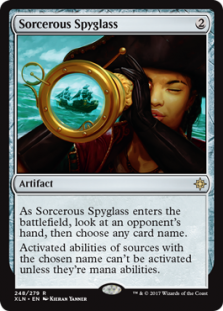 The sideboard features a key difference from previous builds in its bid to run a full set of Sorcerous Spyglass. Previously, I'd bounced between employing Spyglass (which gets around Chalice and offers a bit of extra information) and Pithing Needle (which is importantly one mana cheaper) in CES depending on the metagame. Either way, though, the effect never merited more than 2 slots in the sideboard. Things changed with Kaldheim. Suddenly, every deck and its grandmother seemed to feature the power-play of Oko-plus by cascading on turn two or three into Tibalt, Cosmic Imposter.
The sideboard features a key difference from previous builds in its bid to run a full set of Sorcerous Spyglass. Previously, I'd bounced between employing Spyglass (which gets around Chalice and offers a bit of extra information) and Pithing Needle (which is importantly one mana cheaper) in CES depending on the metagame. Either way, though, the effect never merited more than 2 slots in the sideboard. Things changed with Kaldheim. Suddenly, every deck and its grandmother seemed to feature the power-play of Oko-plus by cascading on turn two or three into Tibalt, Cosmic Imposter.
I soon found that maxing out on Spyglass was the best defense against this new breed of cascade deck. With Tibalt gone, I'm returning to 1-2 copies as a catch-all against decks that happen to have multiple high-value targets like manlands, planeswalkers, utility creatures, and equipment. Similarly, Damping Sphere has game against a heap of Modern decks, but none that we find particularly tough to beat. Except, that is, for Tibalt's Trickery, yet another Kaldheim deck targeted by the recent bannings.
Land Me a Hend
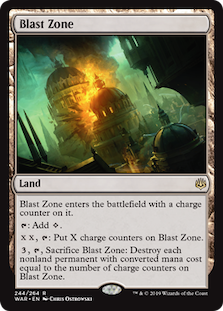 Biggest of all changes here is my move to 26 lands. I abandoned Endless One and Matter Reshaper, cards I long swore by as flex options, when I realized I wanted to be seeing Blast Zone as much as possible. Go-wide creature decks have always been problematic for us to deal with, as have strategies employing tricky permanents like Ensnaring Bridge; against the former, we needed a high density of removal spells, while the latter forced us into freaky sideboard bullets like Ratchet Bomb and for a long time convinced me we needed Karn, the Great Creator in the main 60 so we could fish it out. But Zone deals with both of these.
Biggest of all changes here is my move to 26 lands. I abandoned Endless One and Matter Reshaper, cards I long swore by as flex options, when I realized I wanted to be seeing Blast Zone as much as possible. Go-wide creature decks have always been problematic for us to deal with, as have strategies employing tricky permanents like Ensnaring Bridge; against the former, we needed a high density of removal spells, while the latter forced us into freaky sideboard bullets like Ratchet Bomb and for a long time convinced me we needed Karn, the Great Creator in the main 60 so we could fish it out. But Zone deals with both of these.
While previously I'd carefully rationed the number of Zones to maximize mana spent each turn, increase the diversity of effects on board, and avoid clunking out, I've come to see that in the creature matchups we want all the Zones we can get, and in the Bridge-esque matchups we want to maximize the odds of seeing at least one. After testing with the full set, I ditched both Karn and Bomb, which is where the extra sideboard slots came from.
26 lands did strike me as a lot initially, as I tend to go as low as I can with land counts for the decks I design. But I simply didn't want any spells over the lands I was running. With no Karn to find Relic in game 1, I needed Scavenger Grounds back, and none of the other land counts were negotiable: Temple and Void are absolute 4-ofs; 3 Gemstone is the maximum we can run comfortably; 5 manlands has felt like the sweet spot for years; Ghost and Grounds are great at 2 apiece so we can see them a reasonable amount of the time; gotta have them Wastes for Path, Trophy, Quarter, Field, etc. from the other side... and that's 26!
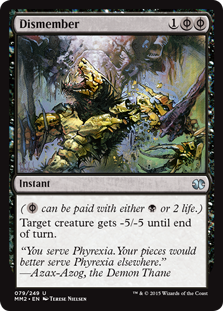 Running so many lands had another positive effect on the deck that I hadn't anticipated, although in hindsight it makes perfect sense. We often get low on cards in the mulligan stage, and having many "spell-lands" in the deck rather than actual spells reduces the pressure on those leaner hands. At 26, we can keep more hands that are light on mana and feel confident the deck will deliver what we need. Plus, there are some matchups where more lands—any lands—are preferred over other cards such as Copter or Dismember (Burn, for instance), and we lack the sideboard space to optimize a plan (these matchups tend to be favorable already).
Running so many lands had another positive effect on the deck that I hadn't anticipated, although in hindsight it makes perfect sense. We often get low on cards in the mulligan stage, and having many "spell-lands" in the deck rather than actual spells reduces the pressure on those leaner hands. At 26, we can keep more hands that are light on mana and feel confident the deck will deliver what we need. Plus, there are some matchups where more lands—any lands—are preferred over other cards such as Copter or Dismember (Burn, for instance), and we lack the sideboard space to optimize a plan (these matchups tend to be favorable already).
Of course, right when I was sold on the high land count and beginning to feel great about the deck's positioning, Wizards banned one of its main components.
A Dirge for Simian
I get that Simian Spirit Guide wasn't banned for pumping out 3/3s a turn ahead of schedule, even if that's what the card often did for CES. In fact, Guide formed an integral part of this deck's strategic core, playing multiple roles throughout the game and across different matchups.
This Is What He Does
As has become tradition when Wizards kicks my low-tier pet deck in the 'nads, let's review what the card in question actually did for the archetype.
- Power out Chalice of the Void: The main reason to run Simian Spirit Guide, on account of turn one Chalice single-handedly beating many Modern decks pre-board.
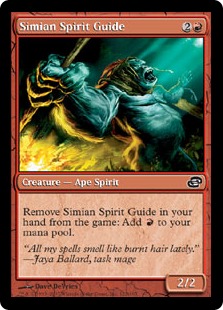 Ramp into TKS or Smasher: Firing off that Thoughtseize effect or swinging for tons a turn early could net us close victories against linear decks. Opened or drawn Smashers became a lot more exciting with 4 Guide in the deck, as at any time we could pluck an Ape from the top and suddenly turn the corner; without Guide, plays like slamming Chalice on 2 would have been out of reach against faster combo decks that demanded it, like Storm.
Ramp into TKS or Smasher: Firing off that Thoughtseize effect or swinging for tons a turn early could net us close victories against linear decks. Opened or drawn Smashers became a lot more exciting with 4 Guide in the deck, as at any time we could pluck an Ape from the top and suddenly turn the corner; without Guide, plays like slamming Chalice on 2 would have been out of reach against faster combo decks that demanded it, like Storm.- Provide general curve fixing: Guide's least exciting function on paper, but a critical one in games, was to plug holes in our mana curve. I've won countless games by simply following Temple, Guide, three-drop into land, three-drop with the usual Eldrazi fanfare.
- Create blowouts with interactive cards: Some combo decks require us to hold up a Relic pop (Storm, Griselbrand, etc.) or removal spell (Counters Company, CopyCat, etc.) after a certain number of turns have elapsed, lest we tap out and lose to the assembled combo. With Guide in hand, we could spend all our mana each turn, slamming as many threats as possible to put the game away fearlessly. In fact, doing so often gave opponents the go-ahead to try the combo, which almost always led to blowouts: they'd sink their precious resources into what looked like a sure thing only for us to pitch the monkey and dismantle their gameplan. I've even created blowouts by pairing Guide with two untapped mana sources and a Blast Zone!
Having Guide in the deck was, in many situations, as useful as finding it in an opener. Those bursts of free mana certainly added up over the course of a match.
If a Monkey Could Do Your Job...
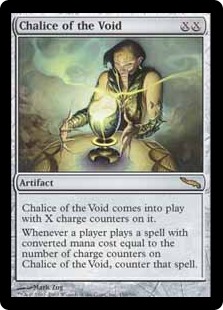 With Guide's praises good and sung, it's time to focus on the task at hand: replacing it. Naturally, Modern contains no free-mana cards as generically splashable as Simian Spirit Guide, which is exactly why the creature was axed. And it's not like we can keep running Chalice of the Void; there are some decks a Chalice on 1 doesn't beat, and even in the matchups where it shines, the artifact can sometimes be too slow if played on turn two. It's a game 1 liability without Guide. Our only hope is to alter the gameplan and deck makeup.
With Guide's praises good and sung, it's time to focus on the task at hand: replacing it. Naturally, Modern contains no free-mana cards as generically splashable as Simian Spirit Guide, which is exactly why the creature was axed. And it's not like we can keep running Chalice of the Void; there are some decks a Chalice on 1 doesn't beat, and even in the matchups where it shines, the artifact can sometimes be too slow if played on turn two. It's a game 1 liability without Guide. Our only hope is to alter the gameplan and deck makeup.
To be fair, I wasn't totally stabbing around in the dark: I'd actually proposed a Guide-less build in the past, back when Eternal Scourge was released and I rebooted this deck from its storied origins. In those days, Dredge was running around at full power, and the deck's first draft omitted the Guides and Chalices it would come to be known for in exchange for full sets of Relic of Progenitus and Endless One. It made sense to start with those swaps and a little re-tooling to see what might happen. Additional tweaks led me to the list below.
We Are Not the Simian, I Am a Martian
On the surface, CES undergoes some very simple switches to account for the Ape ban: 4 Simian Spirit Guide becomes 4 Endless One, and 4 Chalice of the Void becomes 4 Relic of Progenitus. I've also modified the land base a bit. The reasoning for these switches is more involved, and the implications it has on how CES plays and matches up against Modern's gauntlet even deeper.
Alien Zoo, Jordan Boisvert
Aggrophobia
The most obvious change in how CES played: it was suddenly much more aggressive. The deck used to insistently mulligan for openers that featured a fast lock piece or a dreamy curve, and then chase that turn one Chalice with big bodies to put away the game quickly. Now, those big bodies follow not a Chalice, but... littler bodies.
Lacking a dedicated "lock piece" per se, CES becomes less of a stompy deck and more of a pure aggro deck, cf. Zoo. While it can do so, the disruptive artifact that replaces Chalice doesn't tend to lock opponents out of the game nearly as often as it generates additional pressure, looping Scourge into an endless stream of Wild Nacatls. As I wrote about Relic in an antiquity evinced by the deck names:
Relic is less of a lock piece and more a very efficient, self-replacing disruptive permanent. But it’s important to remember that combined with Scourge, it can make combat nightmarish for opponents, which is more desirable than Chalice against certain decks (CoCo/Chord, Zoo, Little Kid Abzan, etc.). That’s in addition to butchering Grixis/Jund/Jeskai/Abzan midrange decks and hosing certain strategies (Goryo’s, Dredge) on its own.
 To boot, the card that replaced Guide, Endless One, is yet another aggressive body, dropping as a 2/2 on turn one and a fatty down the road. One is fantastic in this build, plugging curve holes in the Temple hands while resolving for as low as one mana to crew Copter in a pinch.
To boot, the card that replaced Guide, Endless One, is yet another aggressive body, dropping as a 2/2 on turn one and a fatty down the road. One is fantastic in this build, plugging curve holes in the Temple hands while resolving for as low as one mana to crew Copter in a pinch.
Zoo decks deal themselves plenty of fetch-shock damage and run a mana-centric land base to enable Wild Nacatl, Akoum Hellhound, and the like as reliable, above-rate Stage 1 creatures. Our re-adoption of Endless One sits us closer to Zoo on the aggressiveness spectrum. But imagine: how bonkers would Zoo specifically be if instead of running all those Temple Gardens and Arid Mesas, it could run 4 Mutavault? I haven't looked back since maxing out on the land, a move which further supports our now emphasized aggro bent.
Copping a 'Tude
Another switch I made was to run 3 Smuggler's Copter. (4 can still clog, although I'm not totally opposed to retrying a full set.) The card I once eulogized as a flex spot sees its stock rise significantly sans Simian.
 CES always had two kinds of openers to find with its mulligans: nutty Temple hands and turn one Chalice hands. Scourge represented our third "free win" element, but seldom rendered openers keepable by itself; more often, its distinguished presence in exile would simply excuse our mulling to four or below. On the other hand, Copter did wonders for our openers, possessing the unique ability to jump-start our curve without a Temple in sight. For example, a hand with Temple and Scourge access would cast the 3/3 on turn two and swing 3 the following turn; from there, the deals kept coming. The same hand minus Temple can still make Copter on turn two, then pay full price for Scourge, crew the Vehicle, and swing 3 as though Temple was always in the picture.
CES always had two kinds of openers to find with its mulligans: nutty Temple hands and turn one Chalice hands. Scourge represented our third "free win" element, but seldom rendered openers keepable by itself; more often, its distinguished presence in exile would simply excuse our mulling to four or below. On the other hand, Copter did wonders for our openers, possessing the unique ability to jump-start our curve without a Temple in sight. For example, a hand with Temple and Scourge access would cast the 3/3 on turn two and swing 3 the following turn; from there, the deals kept coming. The same hand minus Temple can still make Copter on turn two, then pay full price for Scourge, crew the Vehicle, and swing 3 as though Temple was always in the picture.
In other words, running Copter in high numbers gives us back the "second plan" we lost with the removal of turn one Chalice. Demanding Eldrazi Temple from every otherwise balanced opener is unreasonable, even with 4 Serum Powder. But Temple or Copter? Fine. Just like Temple or turn one Chalice was fine. And Temple or Eye of Ugin, for those of you old enough to remember the good ol' days. And while turn one Chalice was more impactful, it required two cards to actually come online: Chalice and Simian. Copter is stand-alone, further reducing pressure on our openers.
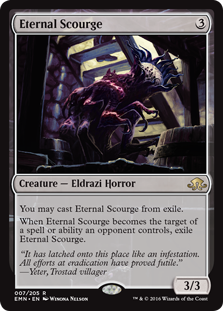 That's not to downplay the fact that turn one Chalice put away games by itself. And Smuggler's Copter is no turn one Chalice. But with that out of the way, Smuggler's Copter is nonetheless phenomenal against basically everything. Removal-heavy midrange decks? Bask in the tempo-sucking warmth of the Splinter Twin effect. Tap-out control? Good luck creaming us with a sweeper, let alone sticking a planeswalker. Creature combo? Excuse me while I soar over the board stall and keep the removal flowing. Burn? Uh... okay, Copter still sucks against Burn (we need the blockers). But everywhere else, it's so high-impact that if they're not straight-up losing to it, opponents find themselves awkwardly sinking resources into removing it, spending valuable tools like Abrade or Assassin's Trophy on our end step only for us to stick another one the following turn. We run three, after all!
That's not to downplay the fact that turn one Chalice put away games by itself. And Smuggler's Copter is no turn one Chalice. But with that out of the way, Smuggler's Copter is nonetheless phenomenal against basically everything. Removal-heavy midrange decks? Bask in the tempo-sucking warmth of the Splinter Twin effect. Tap-out control? Good luck creaming us with a sweeper, let alone sticking a planeswalker. Creature combo? Excuse me while I soar over the board stall and keep the removal flowing. Burn? Uh... okay, Copter still sucks against Burn (we need the blockers). But everywhere else, it's so high-impact that if they're not straight-up losing to it, opponents find themselves awkwardly sinking resources into removing it, spending valuable tools like Abrade or Assassin's Trophy on our end step only for us to stick another one the following turn. We run three, after all!
Another neat thing about Copter is the Eternal Scourge micro-synergy. Pre-Guide ban, this interaction did come up occasionally, but very rarely; now, it's a feasible card advantage engine to get online in certain matchups, even in game 1. How it works: creature crews Copter, Copter discards Scourge, Relic exiles Scourge, Scourge crawls out of exile to crew Copter, and the cycle continues. More commonly, though, the artifact just loots us past extra Gemstones, Powders, and the like so we can draw into business all game.
To Land on Both Feet
I'd also like to touch on the lands and sideboard for this new configuration.
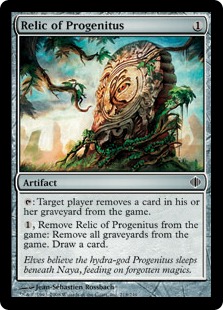 Besides 4 Blast Zone and 4 Mutavault, other changes to the manabase include cutting Scavenger Grounds entirely (we play 4 Relic now) and maintaining Gemstone Caverns at 3. I did try 4, both with a sided copy and a mainboarded one, but found that it was overkill; the legend clause can really bite us with that many (or else I'd max it fa sho), and there are some matchups where starting "on the play" at the cost of a card isn't even worth it unless we happen to have Scourge (e.g. against attrition decks such as Rakdos Midrange). Caverns is at its best against linear combo and aggro decks, where the speed boosts from Simian are most sorely missed.
Besides 4 Blast Zone and 4 Mutavault, other changes to the manabase include cutting Scavenger Grounds entirely (we play 4 Relic now) and maintaining Gemstone Caverns at 3. I did try 4, both with a sided copy and a mainboarded one, but found that it was overkill; the legend clause can really bite us with that many (or else I'd max it fa sho), and there are some matchups where starting "on the play" at the cost of a card isn't even worth it unless we happen to have Scourge (e.g. against attrition decks such as Rakdos Midrange). Caverns is at its best against linear combo and aggro decks, where the speed boosts from Simian are most sorely missed.
...With a Side of Hate
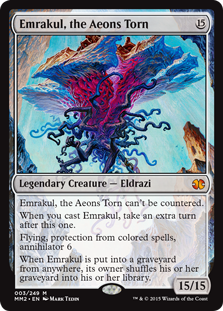 The sideboard is always subject to change, but here's a down-and-dirty for the above list:
The sideboard is always subject to change, but here's a down-and-dirty for the above list:
Chalice takes the place of Relic in the sideboard, still coming in for the matchups that it dominates like Infect, Hammertime, Burn, etc. I also like a couple copies against interactive decks, where it can set up unfadeable Copter attacks but risks clashing with Relic. Crucible has lots of different applications depending on the matchup, and is the main "Karn target" I've decided to keep around, while Spyglass is fine at 2 to hassle combo and the odd Tron deck (between Smasher, Copter, and Muta, planeswalkers are less cumbersome than ever before). And our Mill matchup is indeed favorable, but it's not 100%. I feel like any deck with some breathing room in the sideboard should consider a copy of Emrakul, the Aeons Torn when Mill is a tiered deck.
Reality Check
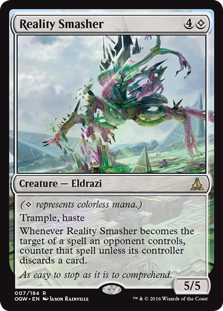 Simian Spirit Guide powered Colorless Eldrazi Stompy's most impressive openers, leading to utter nonsense like turn one Chalice (common) and turn two Reality Smasher (with some luck). Heck, I've even turn one'd a Smasher!
Simian Spirit Guide powered Colorless Eldrazi Stompy's most impressive openers, leading to utter nonsense like turn one Chalice (common) and turn two Reality Smasher (with some luck). Heck, I've even turn one'd a Smasher!
Those days may be past, but color me optimistic about Colorless Eldrazi. First, this new form closely resembles some of our optimal configurations, such as vs. Jund (we'd board out Chalice and Simian for that matchup). Second, reactive decks cannot and will not ever be comfortable sitting across from Eternal Scourge. And finally, Wizards ain't done printing cards that slot right into this deck. Zhalfirin Void and Blast Zone were major upgrades for us, and the relatively recent Smuggler's Copter makes this build possible at all. Mark my words, there are pushed colorless lands and utility artifacts galore on the horizon. I, for one, am not throwing the spaghetti out with the pasta water!




